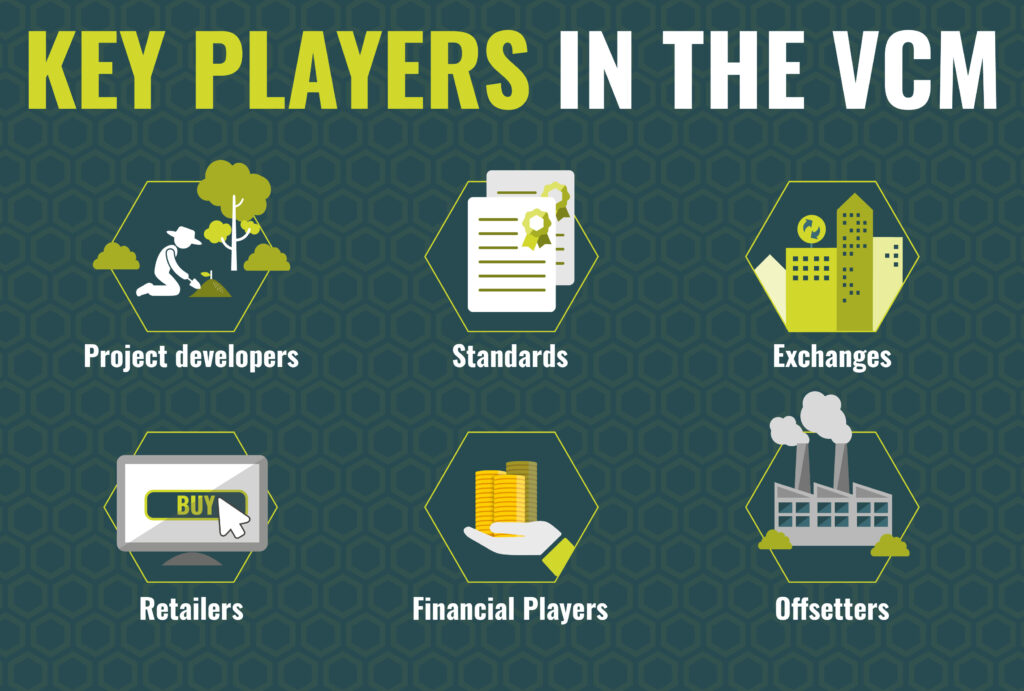HOW ARE CARBON CREDITS USED?
Carbon credits can be used by individuals, companies, countries and any organisation to counterbalance the negative impact of their residual carbon emissions.
They can also be used by investors or other financial players who wish to take a position in the carbon market with the aim of benefiting from a change in the price for the type of carbon credit they buy or sell.
WHERE TO BUY CARBON CREDITS
Carbon credits can be bought via:
- Carbon Exchanges
- Carbon Retailers
- Carbon Projects
Buyers can purchase carbon credits via a carbon exchange, a carbon retailer or directly from a project that generates credits. For example, a company can calculate its unavoidable carbon emissions and may buy and retire an equal amount of carbon credits to counterbalance the negative impact of those emissions.
An individual might want to buy and retire carbon credits to offset the carbon footprint generated by a plane journey they have taken.
An individual who has taken a flight from Rome to Hong Kong could calculate the carbon footprint of their share of the flight and might want to offset that by buying an equal amount of carbon credits.
Although the primary goal of the carbon markets is to allow individuals and organisations to offset their residual carbon emissions and reduce the overall amount of CO2 in the atmosphere, financial players play a valuable role as they increase liquidity in the market. Higher trading volumes tend to make finding the right price quicker and reduce trading fees.
1-Carbon Exchanges – A few exchanges have emerged in the past few years. Their function is to make trading more efficient, which could help the voluntary market scale up. They often make trading quicker and pricing more transparent.
Among the biggest carbon credit exchanges are ACX and Xpansive CBL. They offer various standardised products on a digital platform and have lower transaction fees than retailers. Financial players and some large corporations often prefer them.
Exchanges are also used at times to settle bilateral deals agreed off-screen. The minimum lot size and KYC checks can be prohibitive for small companies and individuals looking to buy only a few tonnes worth of carbon credit.
2-Retailer – Retailers buy large amounts of credits from suppliers and sell them in smaller lots. They can be a good option for individuals or small and medium companies looking to buy up to about 1,000 tonnes.
There are hundreds of retailers selling credits online but pricing and markups vary hugely, so it is essential for a buyer to ask for clarity on how much of the funding flows back to the project and what the markups applied by the retailer are. Retailers generally retire the certificate on behalf of the client.
3-Carbon Project Developer – Buyers can make bilateral agreements with specific project developers if they want to have more control over the provenance and the quality of the carbon credit.
A project generates carbon credits only if and when it is verified and approved by a standard, but a buyer can agree to finance a particular project in exchange for future delivery of carbon credits at any stage of the project’s development for a price agreed between the buyer and the project developer.
This is often an option for large organisations that have dedicated teams that research various projects and identify one or more that they think is more suitable and valuable for their specific need.

KEY PLAYERS IN THE VCM
Project developers
Projects can be of various types and sizes, from small cookstove projects in remote African regions to avoided deforestation projects that cover hundreds of thousands of hectares. The projects are designed and developed and can be funded by investors in exchange for credits to be delivered at a later stage. All projects need to be verified and approved by one of the standards in order to generate carbon credits.
Standards
To generate carbon credits from a project, a developer needs to submit the project details and the methodology for calculating emissions reductions to one of the standards.
Standards organisations, commonly referred to as ‘standards’ or ‘crediting programmes’, are international private organisations which set rules, requirements and methodologies for the issuance of carbon credits from a project.
They approve the methodologies to calculate reductions, avoidances or removals of atmospheric CO2. If satisfied, they issue one credit for each tonne of CO2 that a specific project reduces.
The standards rely on independent certification and audits of projects and, if satisfied, issue carbon credits for the project.
Standards use registries to keep track of each credit generated.
Measured by credit issuance, the most prominent standards currently operating are:
Verra
Gold Standard
American Carbon Registry
Climate Action Reserve
Retailers
Retailers buy credit in larger volumes and resell them in smaller lots. In most cases, retailers add a fee for the service to the credits, and these fees can vary hugely, so it’s important for an offsetter to ask for clarity on these markups.
Retailers generally retire the credits on behalf of the buyer.
Exchanges
They offer a trading platform for developers, offsetters and financial players to trade carbon credits. Exchanges set minimum trade sizes and carry out credit and money laundering checks, which make them a viable option for organisations looking to trade larger volumes of carbon credits.
Financial Players
These could be individual investors or large financial firms making a bet on where they expect the price of carbon to move with a view to make an economic profit. Financial players can play a valuable role in the carbon market as they can fund projects and increase liquidity in the market. Higher trading volumes tend to make trade quicker and less costly.
Offsetters
These are individuals, companies, countries or organisations which buy carbon credits with a view to retiring them in the short term. These kinds of buyers purchase credits to offset their carbon emissions rather than to make a financial profit.
LIFE CYCLE OF A CARBON CREDIT
Carbon credits are generated by a project when one of the standards certifies that the project reduces or removes carbon emissions. Each credit represents a tonne of CO2 that the project is calculated to reduce or remove.
Once the credits are issued, the project developer can sell them to a buyer directly, via an exchange or via a retailer. The developer might also have already pledged some or all of the credits to an investor in the project.
The carbon credits might then be bought by a financial player, who could hold on to the credit before selling back to the market, hoping to make a profit, or to an offsetter who is likely to retire the credits in order to counterbalance their emissions.
Carbon credits are logged in electronic registries to guarantee ownership and ensure that credit cannot be retired more than once. Carbon credits effectively cease to exist after they have been retired.






